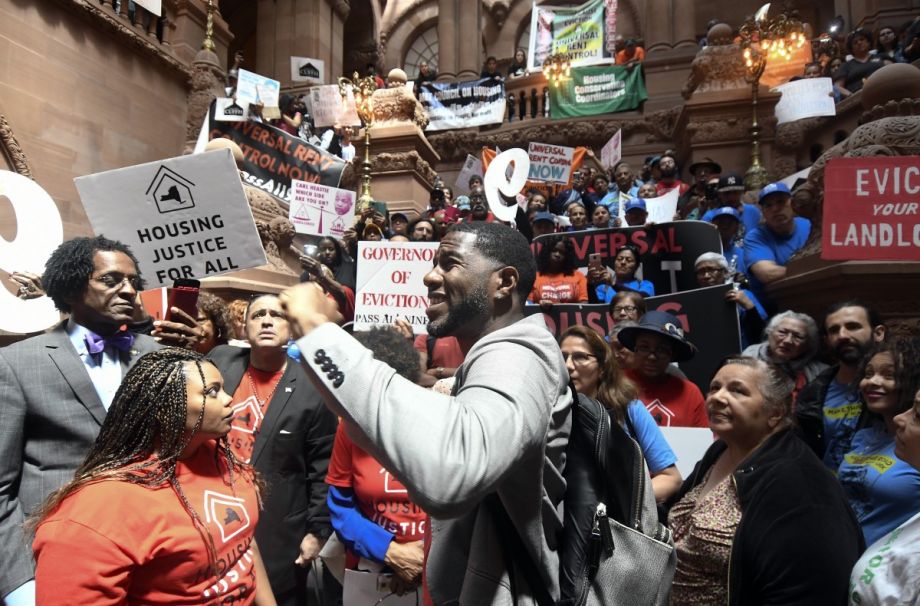They didn’t get everything they wanted, but last week, when a coalition of advocates from across New York state celebrated a package of new laws expanding rent regulation and tenant protections, it was as much of a shot in the arm for the housing-rights movement as any in recent memory.
In New York City, landlords will no longer be allowed to jack up the cost of rent-stabilized apartments by 20 percent when tenants leave. The new laws also end so-called vacancy decontrol, which allows landlords to take a unit out of rent regulation when it is vacant and the rent surpasses $2,700 a month. (Together these practices add up to the “grandaddy of loopholes,” as my colleague Oscar put it last year.) New laws will also limit how much landlords can raise the rent when they’re performing capital repairs on apartment buildings. For the first time, these reforms will be made permanent, as opposed to expiring every few years as usual. And under the expansion of the Emergency Tenant Protection Act (ETPA), cities around the state will be allowed to establish their own rent-control policies during housing emergencies, defined as when the vacancy rate is under five percent.
It was the alliance of tenants and homeless New Yorkers in New York City and smaller cities around the state that made the new laws possible, says Sarah Treuhaft, managing director at PolicyLink. Earlier this year, PolicyLink released a report in conjunction with the Right to the City Alliance and the Center for Popular Democracy advocating for the expansion of rent control nationwide. Expanding rent control could stabilize 42 million households, the report concluded, with low-income tenants of color standing to gain the most benefits. The report highlighted rent-control campaigns around the country, including New York’s.
“I think the New York campaign really shows the payoff of a movement-building approach long-term,” Treuhaft says. “Tenant organizing, alliances across rural and urban communities, and campaigns to put people in office who represent the interests of everyday renters instead of the real estate lobby were all incredibly crucial to this win. And it took years to get there, so I think other campaigns should be looking at those strategies and learning from them.”
The ETPA was created in 1974, a state law that authorized rent stabilization in three counties surrounding New York City and amended the rent stabilization laws in the city. So the push to expand it had to take place in Albany. Housing Justice for All, a coalition of dozens of tenants groups convened as part of the Upstate/Downstate Housing Alliance, built pressure on lawmakers as it made the case for more tenant protections. Cea Weaver, the campaign coordinator for Housing Justice for All, says that tenants in New York City and smaller cities in the state have usually been divided — and that’s been an intentional strategy on the part of real estate interests, she says. Uniting tenants across the state was the most important strategy in the campaign, Weaver says. And tying tenants’ rights to homelessness was a critical move as well, she says.
“New York has a skyrocketing homelessness crisis, and too often, homelessness and tenants’ rights are separate apart from each other even though to me it’s an obvious connection,” Weaver says. “If you have weak tenants’ rights, you are going to have a rising homelessness crisis.”
New York City has a strong history of tenant organizing, and, Weaver notes, it has kept much of its public housing while other cities have lost it. It has also maintained rent control in the city, though the strength of the regulations has waxed and waned. It’s also the home of Wall Street and a powerful real estate lobby, and for all those reasons, the city is on the front line of the fight for better conditions for tenants.
“For us it was strategically critical, and also just morally critical, that we build a movement of tenants and homeless New Yorkers together, and upstate and downstate [connections],” Weaver says.
Notably, one major reform that the Housing Justice for All Campaign failed to win was a “good cause” provision, which would have prevented landlords from evicting tenants without providing a reason. Tenants in jurisdictions around the U.S. have been pushing for such provisions, with varying degrees of success. Philadelphia, for example, enacted a good-cause bill in January, though after pressure from landlords who said an inability to evict “problem” tenants would harm their ability to retain “good” tenants, it was altered to apply only to certain short leases. In New York, Weaver says, the “good cause” provision represented the most direct challenge to the real estate industry, because it approaches policymaking from a housing-rights framework rather than a property-rights framework. Many in New York — even affordable housing advocates — still believe landlords should be able to do pretty much whatever they want with their buildings, Weaver says. The campaign will push for good cause again next year, she says.
Across the country in California, lawmakers have also been debating a series of proposed changes to rent-control laws and tenant protections. Last year, Californians rejected a measure that would have repealed Costa-Hawkins, a state law that limits the kinds of rent-control policies that cities can establish. This year, state lawmakers are in the middle of debating another series of tenant protections. Shanti Singh, a communications coordinator with the California statewide renters’ rights group Tenants Together, says she hopes California’s lawmakers look to New York and “feel a pang (or ten) of guilt.”
“That New York repealed vacancy decontrol is tremendous,” Singh wrote in an email. “Costa-Hawkins is basically the Bible of the Sacramento Capitol, and the great white whale of every tenant advocate in California. That the Upstate-Downstate [Alliance] was able to pass these protections despite a real estate lobby that is as dominant in New York as it is in California, is a great sign.”
Still, Singh said the lack of a good cause provision in New York, and the likelihood that California lawmakers will not establish a strong provision either, were reasons not to declare total victory.
“Having to specify cause to evict a tenant is pure common sense, and the simple reason that the real estate industry opposes just-cause is because they want to have the freedom to evict tenants who follow the rules whenever they so choose,” Singh wrote. “So there’s still a lot of work to do, but we’ll keep organizing more and more exploited renters until we win :)”
EDITOR’S NOTE: This article has been updated to clarify Costa-Hawkins, California’s rent statewide rent control law.
This article is part of Backyard, a newsletter exploring scalable solutions to make housing fairer, more affordable and more environmentally sustainable. Subscribe to our weekly Backyard newsletter.

Jared Brey is Next City's housing correspondent, based in Philadelphia. He is a former staff writer at Philadelphia magazine and PlanPhilly, and his work has appeared in Columbia Journalism Review, Landscape Architecture Magazine, U.S. News & World Report, Philadelphia Weekly, and other publications.
Follow Jared .(JavaScript must be enabled to view this email address)


















